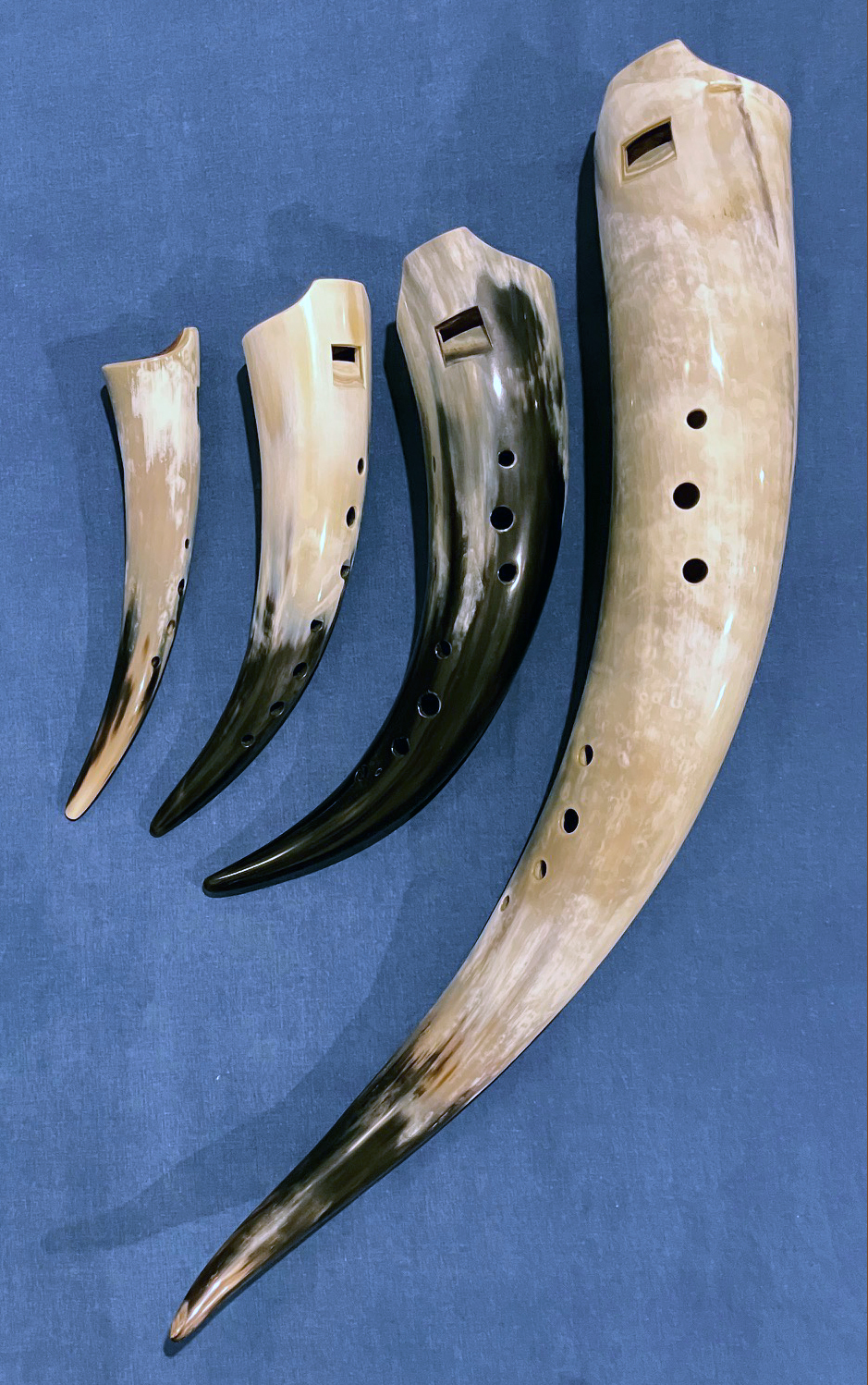
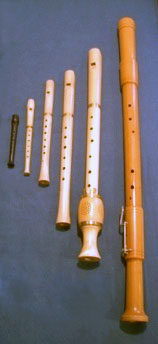
The Recorder. This wooden end-blown flute came in various sizes which were often played together inconsorts during the Renaissance. Pictured from left to right are the piccolino, sopranino, soprano, alto, tenor, and bass recorders.
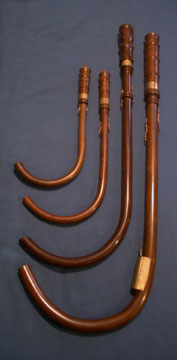
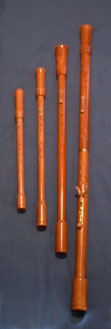
The Cornemuse. This capped-reed instrument is straight, rather than curved, and is somewhat quieter and sweeter in tone than the crumhorn. Pictured from left to right are the soprano, alto, tenor, and bass cornemusen.
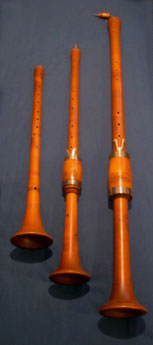
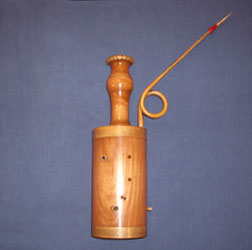

The Sackbut. This predecessor to the modern trombone originated in the late 15th century. Like the modern trombone, it was operated by a telescopic slide to achieve different pitches. Its name is derived from the French words sacquer (to pull) and bouter (to push), thereby describing the player’s movements in operating the slide mechanism.
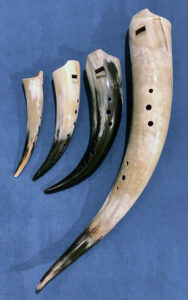
During the Middle Ages, the word gemsbok was a generic term for any kind of ruminant animal,such as the chamois or antelope. The sound of the gemshorn is like a recorder, but softer and sweeter.

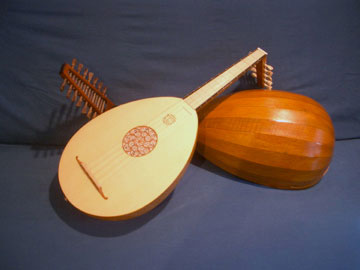
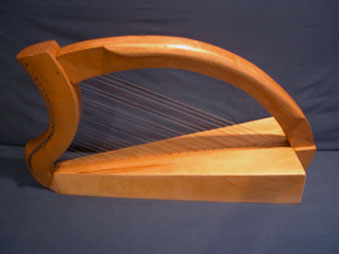
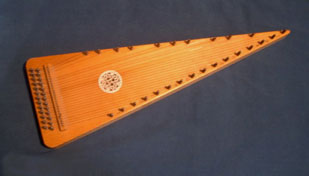
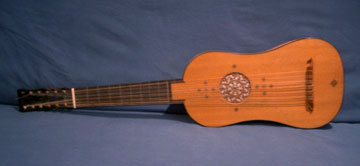

The Scheitholt. This plucked stringed instrument is a rectangular zither, with three or four strings that are played in similar style to a dulcimer. The instrument sits on a table or in the player’s lap, and the left hand presses the strings with a wooden stick called a “noter,” while the right hand plucks the strings with either the fingers or with a wooden plectrum or goose quill. Some of the strings act as drones to support the melody.
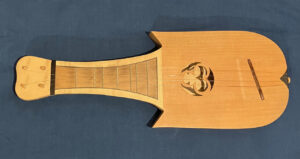
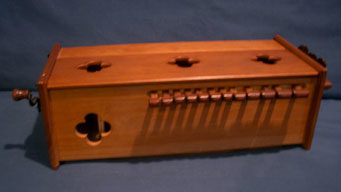
The Hurdy Gurdy. This unusual instrument, also called an organistrum, had two drone strings which sounded by means of a crank and rosined wheel, while a third string produced the melody when stopped by keys.
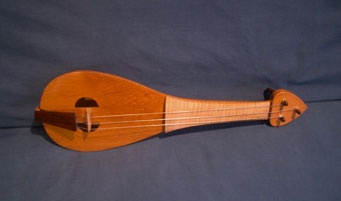
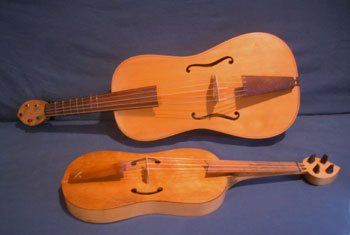
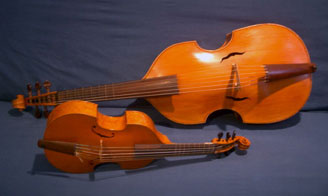

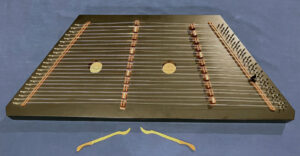

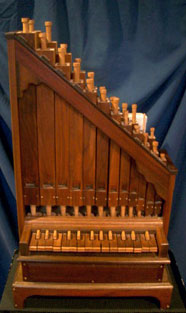
The Portative Organ. A small portable organ with
bellows operated by the player.
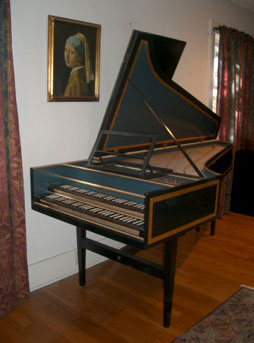

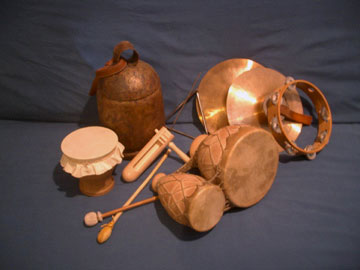
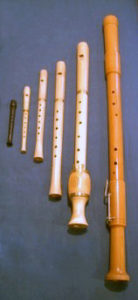
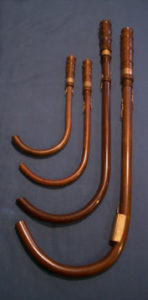
The Recorder. This wooden end-blown flute came in various sizes which were often played together inconsorts during the Renaissance. Pictured from left to right are the piccolino, sopranino, soprano, alto, tenor, and bass recorders.
The Crumhorn. This capped reed instrument
produced a buzzing nasal tone. Its name, which means
“curved horn,” described its characteristic shape.
Pictured from left to right are the soprano, alto, tenor and bass crumhorns
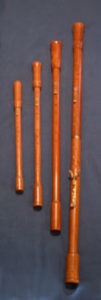
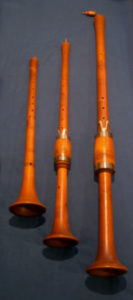
The Cornemuse. This capped-reed instrument is straight, rather
than curved, and is somewhat quieter and sweeter in tone than
the crumhorn. Pictured from left to right are the soprano, alto, tenor, and bass cornemuse.
The Shawm. This predecessor of the modern
oboe was the most important exposed-reed
instrument of the Middle Ages and Renaissance.
Pictured from left to right are the soprano, alto,
and tenor shawms.

The Racket. The racket (or ranket) was a small double-reed wind
instrument of the 16th and 17th centuries. It had a narrow cylindrical bore
folded into a number of parallel tubes, and therefore produced a very low pitch
relative to its size, similar in character to the bassoon.
 The Sackbut. This predecessor to the modern trombone originated in the late 15th century. Like the modern trombone, it was operated by a telescopic slide to achieve different pitches. Its name is derived from the French words sacquer (to pull) and bouter (to push), thereby describing the player’s movements in operating the slide mechanism.
The Sackbut. This predecessor to the modern trombone originated in the late 15th century. Like the modern trombone, it was operated by a telescopic slide to achieve different pitches. Its name is derived from the French words sacquer (to pull) and bouter (to push), thereby describing the player’s movements in operating the slide mechanism.

The Gemshorn. This wind instrument is classified in the ocarina family. It was primarily a pastoral instrument and was historically made from the horn of a gemsbok (hence the name). During the Middle Ages, the word gemsbok was a generic term for any kind of ruminant animal, such as the chamois or antelope. The sound of the gemshorn is like a recorder, but softer and sweeter.
The Bladderpipe. This medieval wind instrument has a reed enclosed inside an animal bladder that serves as a wind reservoir, making it possible for the player to breathe while the instrument keeps sounding. One of the pipes serves as a drone, while the other can be fingered to produce melodies. The resulting sound is similar to that of a bagpipe.
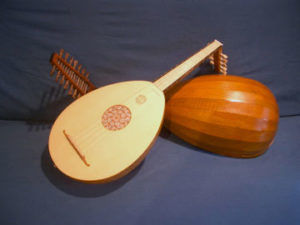
The Lute. This fretted, plucked-string instrument has
a pear-shaped body, a flat soundboard featuring an ornate rosette, and a peg box at nearly a right angle to the neck. Its gut strings are usually in pairs, or courses. The ancestor of the lute is the Arabic ‘ud, introduced into Spain by the Moors beginning in 711 A.D.
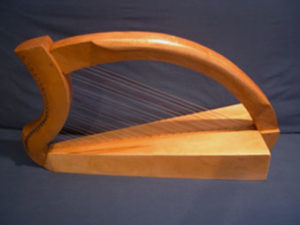
The Harp. The harp first appeared in medieval Europe in the 8th century. It was used for both solo and ensemble music, and was especially popular for accompanying singers of ballads and epic poetry.
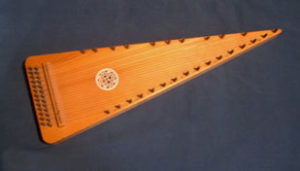
The Psaltery. Imported to Europe during the Crusades, the psaltery had strings stretched over a flat soundbox and was plucked with either quills or fingers.
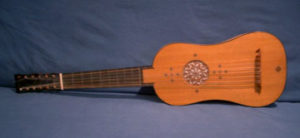
The Vihuela de Mano. The vihuela’s six double
courses of gut strings produced a lute-like sound.
During the Renaissance its prestige in Spain was
equal to that of the lute elsewhere.

The Scheitholt. This plucked stringed instrument is a rectangular zither, with three
or four strings that are played in similar style to a dulcimer. The instrument sits on
a table or in the player’s lap, and the left hand presses the strings with a wooden
stick called a “noter,” while the right hand plucks the strings with either the fingers
or with a wooden plectrum or goose quill. Some of the strings act as drones to support the melody.
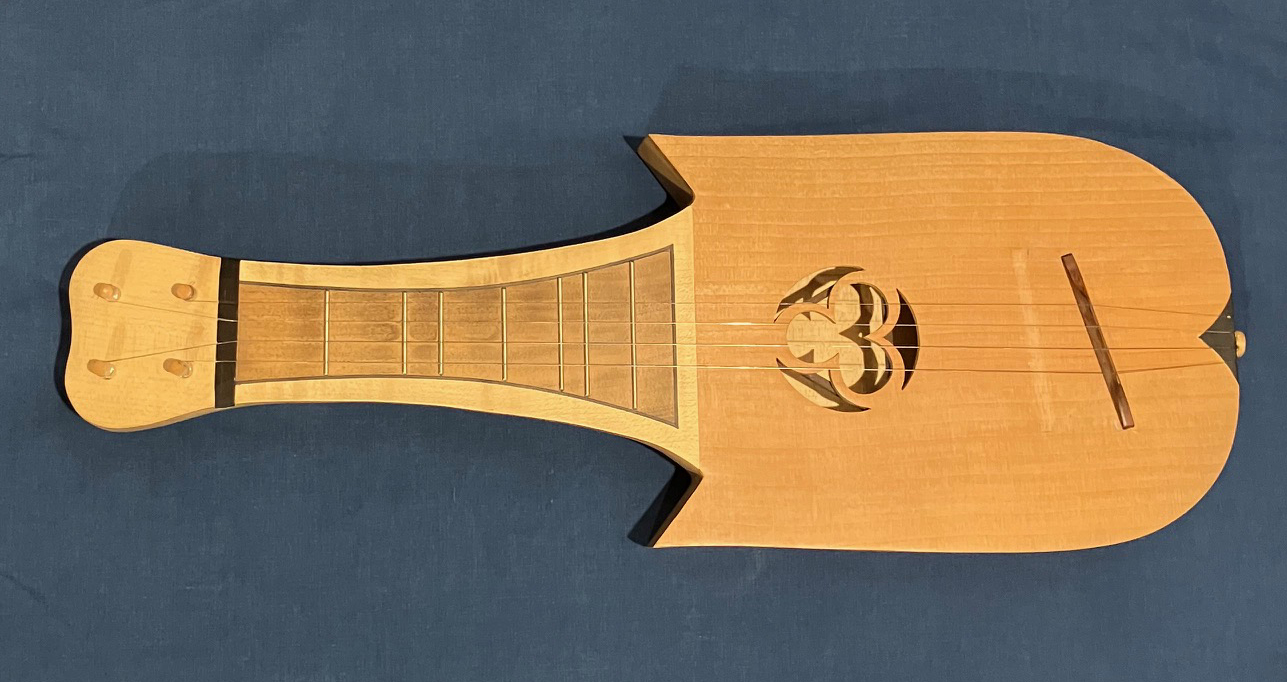
The Cetra. The cetra, often confused with the citole, was a medieval Italian plucked
string instrument. It had a spatulate or spade-shaped body, with characteristic “horns,”
and raised block frets. Gut strings were originally used, but metal ones later appeared.
The tuning is conjectural—Tinctoris described it as “a tone, a fourth, and back a tone,” but
he doesn’t specify whether he meant from top to bottom or vice versa. It is generally
accepted to be e’, d’, g, and a, starting from the top.

The Hurdy Gurdy. This unusual instrument, also called an
organistrum, had two drone strings which sounded by means of
a crank and rosined wheel, while a third string produced the melody
when stopped by keys.
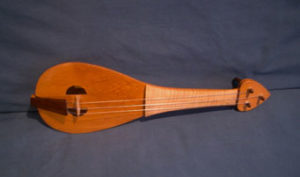
The Rebec. This medieval bowed string instrument is related to the Arabic rabab, and
was introduced into Europe probably in the tenth century. Today it is found in folk cultures of southeastern Europe.
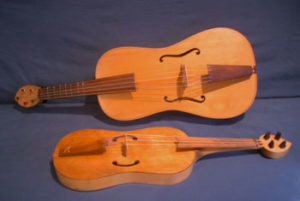
The Vielle. The vielle, or fiedel, was a medieval precursor
of the violin. The size of the instrument varied, as did the
number of strings and their tuning.
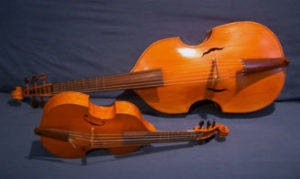
The Viola da Gamba. The viol, as it is usually called, emerged in the later 15th century. It had six strings and a fretted fingerboard,and came in several sizes. Pictured from bottom to top are the treble and bass violas da gamba.

 The Hammered Dulcimer. This percussion-stringed instrument has metal strings stretched over a trapezoidal soundboard. It usually has two bridges, and its strings are struck by spoon-shaped mallets. The hammered dulcimer was used throughout Europe in the Middle Ages, and was known by various names, including Hackbrett, cimbalom, salterio, and tympanon.
The Hammered Dulcimer. This percussion-stringed instrument has metal strings stretched over a trapezoidal soundboard. It usually has two bridges, and its strings are struck by spoon-shaped mallets. The hammered dulcimer was used throughout Europe in the Middle Ages, and was known by various names, including Hackbrett, cimbalom, salterio, and tympanon.
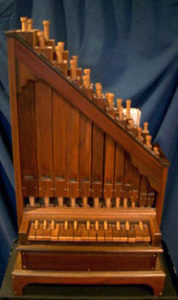
The Portative Organ. A small portable organ with
bellows operated by the player.
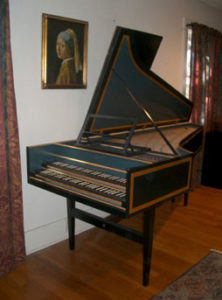
The Harpsichord. The harpsichord was the primary keyboard instrument from about 1500-1775. The strings are plucked rather than hammered. It is best known for its function as the “continuo” half of the “basso continuo” line in Baroque music.

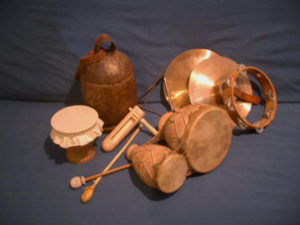
Percussion instruments were used in the music of the Middle Ages and
Renaissance, particularly in instrumental dance music. Percussion
instruments, like many of the early stringed instruments, were nonstandardized,
and were made from various materials. Pictured are a
small skin-head ceramic drum, a bell, a ratchet, a triangle, cymbals,
a tambourine, and a double-headed ceramic drum called the naqqara.
Música Antigua de Albuquerque
1017 Roma NE
Albuquerque, NM 87106-4733
(505) 842-9613
musicaantigua@comcast.net
Send questions or comments about this website to musicaantigua@comcast.net
All information, images, and materials contained herein are copyright © 2021 by Música Antigua de Albuquerque unless otherwise noted.
Last updated August 10, 2021

